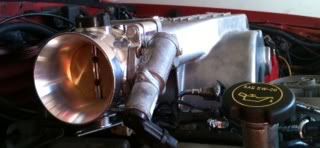Food for thought
Even on a relatively mild 406ci small-block Chevy with a hydraulic roller cam, a spring incorporating the latest technology can make a big difference. Westech Performance tested a traditional Comp Cams dual spring with damper (PN 954) against one of Comp's new single beehive springs (PN 26918). The 954 developed 210 pounds on the seat and 523 pounds open, compared with the 26918's 130/318-pound specs. Both springs were installed with titanium retainers and locks, yet the beehive combination was still 52 grams lighter. If the engine's steel valves had been replaced with titanium valves instead, the weight savings would have been just 40 grams.
Overall peak output was virtually the same: 418.4 lb-ft for the 954 versus 416.9 lb-ft for the 26918, both at 4,800 rpm; and 418.2 hp versus 419.3 hp for the 954 and 26918, respectively, at 5,800 rpm. Average output throughout the 2,500- to 7,000-rpm test range varied by only about two numbers. But above 6,500 rpm, the difference was huge: The new-tech 26918 effectively extended the engine's rpm range, proving to be worth 15 to 36 hp and 12 to 28 lb-ft on top. The stiffer 954 did produce more low-end torque because its higher loads were actually bending the other components, effectively decreasing duration at the valve.

Even on a relatively mild 406ci small-block Chevy with a hydraulic roller cam, a spring incorporating the latest technology can make a big difference. Westech Performance tested a traditional Comp Cams dual spring with damper (PN 954) against one of Comp's new single beehive springs (PN 26918). The 954 developed 210 pounds on the seat and 523 pounds open, compared with the 26918's 130/318-pound specs. Both springs were installed with titanium retainers and locks, yet the beehive combination was still 52 grams lighter. If the engine's steel valves had been replaced with titanium valves instead, the weight savings would have been just 40 grams.
Overall peak output was virtually the same: 418.4 lb-ft for the 954 versus 416.9 lb-ft for the 26918, both at 4,800 rpm; and 418.2 hp versus 419.3 hp for the 954 and 26918, respectively, at 5,800 rpm. Average output throughout the 2,500- to 7,000-rpm test range varied by only about two numbers. But above 6,500 rpm, the difference was huge: The new-tech 26918 effectively extended the engine's rpm range, proving to be worth 15 to 36 hp and 12 to 28 lb-ft on top. The stiffer 954 did produce more low-end torque because its higher loads were actually bending the other components, effectively decreasing duration at the valve.





Comment